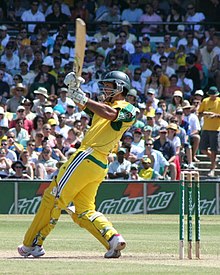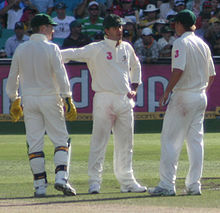Ricky Ponting
[48] Ten days after the double century, Ponting was named in the Australian XI to take on England at Bellerive Oval—in a match that was used as practice before the upcoming series in the West Indies.
[70] Ponting scored 119 runs at 39.66 in the three-Test home series against New Zealand in 1997–98, including a breezy 73 not out from 85 balls in the second innings of the First Test in Brisbane to help Australia set a winning target.
South African all-rounder Jacques Kallis could not bowl because of strained abdominal muscles and the batting pair attacked the replacement bowlers, scoring 82 from 10 overs.
[107] Despite all his good fortune, Ponting slid into the boundary fence and seriously damaged his ankle during the second final against Pakistan, forcing him to miss the upcoming ODI series' in New Zealand and South Africa.
[109] Though not known for extravagant claims, Steve Waugh told a journalist that Ponting could easily be the best batsman in the world, and put him alongside Sachin Tendulkar and Brian Lara.
He proceeded to score 119 from 123 balls (nine fours and three sixes) in Australia's second match of the series—again against England, this time at the MCG—sharing an all wicket record Australian ODI partnership of 225 with Adam Gilchrist in the process.
When the one-day leadership duties were passed over to Ricky in South Africa, my main piece of advice to him was, 'Make sure you take care of your own game and maintain your form, because everything else will follow from that.'
Since assuming the mantle, Punter has shown himself to be among the top three batsmen in the world in both forms of the game, and has elevated his hunger and desire for runs to a level most can only aspire to.Ponting started with a 3–0 clean sweep of the Test series in Sri Lanka.
[161] Up to this point, Ponting's prolific form with the bat in 2003 had tapered away following his ascension to the captaincy and he had not made a century in eight Tests, a long period by his standards.
In the second innings, Ponting was well set on a score of 48, and England was in some difficulty due to an injury to key paceman Simon Jones, when the Australian captain was run out by a direct hit from the substitute fielder (Gary Pratt).
Ponting reacted angrily, directing an abusive tirade at the English support team in the pavilion concerning the liberal use of substitutes as he walked into the Australian rooms.
England had routinely used substitutes so that their bowlers could receive massages between their spells, but in this case, Pratt was on the field due to an injury to Jones, who had been taken to hospital and would go on to miss the fifth and final Test match of the series.
Following the Ashes defeat, Australia were expected to struggle against the World XI, but bounced back to whitewash them 3–0 in the ODIs; they also won the only Test easily, Ponting scoring 46 and 54.
This was ruled by the MCC to have contravened Law 6.1, which states that bats have to be made of wood, although they may be "covered with material for protection, strengthening or repair not likely to cause unacceptable damage to the ball".
Remarkably his performance at Durban meant that Ponting had scored twin centuries in three separate Tests between November 2005 and March 2006, as part of 1192 runs at 79.5 in nine matches over the same period.
After the final in Mumbai, Ponting drew some criticism for appearing to ask BCCI president and Indian cabinet minister Sharad Pawar to "leave the podium" and pointing towards the exit with his finger, while his teammate Damien Martyn pushed him gently in the back so that his team could commence celebrations.
Australia were defeated by 320 runs and Ponting was criticised for using part-timer bowlers against the free-scoring Indian batsmen in the second innings, because of a slow over-rate, which is can be penalised by a fine, or in severe instances, a ban to the captain.
[217] However, the Australians were a long way behind on their over rate, so in order to avoid a one match suspension, Ponting chose to bowl their part-time spinners and medium pacers such as Michael Clarke, Cameron White and Mike Hussey (who were all unsuccessful in capturing a wicket), as they took less time.
In the first Test against South Africa in Perth, starting in December, Ponting again had to reduce his reliance on his preferred pace bowlers, and rely more on spinners due to a slow over rate.
Ponting's inexperienced attack had trouble dismissing the opposition batsmen, and South Africa made 4/414, the second highest successful runchase in history to win by six wickets on the final day.
With the retirement of experienced opening batsman Matthew Hayden—who was replaced by the uncapped 20-year-old Phillip Hughes—the Australian team that toured South Africa in February, March and April 2009 was its most inexperienced since the defections to World Series Cricket.
During the innings, Ponting became the third batsman to score 12,000 ODI runs and was also involved in a record 252-run partnership with Watson—Ponting's seventh double-century stand for Australia in the format; the only player to achieve this feat.
[78] Leading West Indian batsmen Chris Gayle and Shivnarine Chanderpaul returned for the opening Test of the 2009–10 Australian cricket season starting on 26 November in Brisbane, after the industrial dispute was resolved.
[257] Matters got worse for Ponting, as former Australian fast-bowler Rodney Hogg voiced that he should be sacked as captain and replaced with New South Wales leader Simon Katich.
[259][260] Michael Clarke replaced Ponting at his number three batting position, as the Australia captain did not want to risk further damage to his elbow tendon injury ahead of the Boxing Day Test against Pakistan in Melbourne.
[261] After spending time in a hyperbaric chamber to increase the speed of his recovery from the elbow injury,[262] Ponting recovered sufficiently to play in the Boxing Day Test, the opening match of a three-Test series against Pakistan.
Australia were dismissed for 127, and Ponting was re-dismissed from a short ball, this time for a first-ball duck, and many sections of the media called for him to stop playing the hook and pull shots.
[283] Australia sealed the series win by defeating India in Perth, and in the fourth Test in Adelaide, Ponting and Clarke beat their own record, putting on 386 runs.
However, he had some technical weaknesses, such as shuffling across his stumps and being trapped leg before wicket, and thrusting his bat away from his body—especially early in his innings, because he wants to move forward and across to drive rather than backwards and across to cut the ball.
[citation needed] Former West Indian captain, Viv Richards, who was rated as the third best Test cricketer in a 2002 poll by Wisden, said Ponting was his favourite current-day player to watch, slightly ahead of Sachin Tendulkar.












